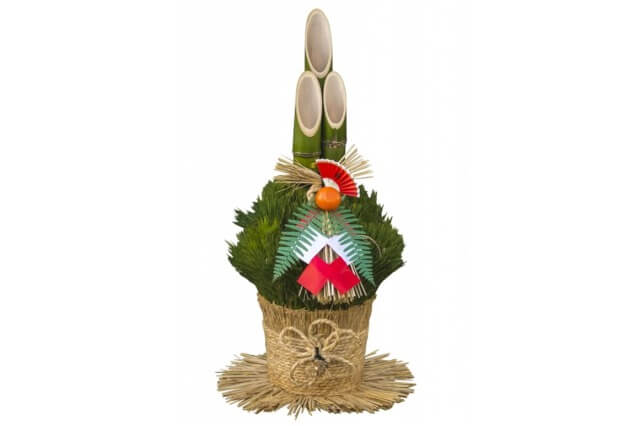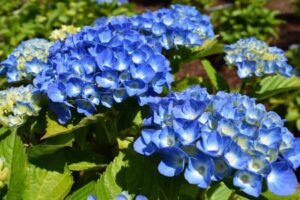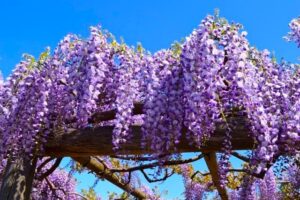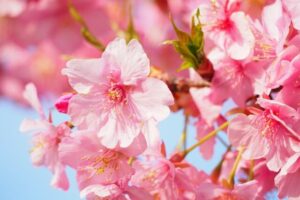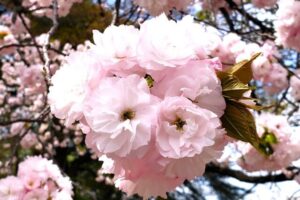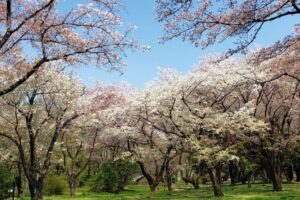外国人から「門松って何ですか?」と聞かれたら、英語で答えられますでしょうか?
 woman
woman(「門松」って何ですか?)



門松って英語で何て説明すればいいのかしら?
外国人に門松をどうやって説明すればいいのか?
そんな疑問にお答えします。
門松は英語で「New Year’s decoration made of pine and bamboo(松や竹で作った正月飾り)」です。



(門松は、お正月に家の前などに飾られる、松や竹で作った正月飾りです。)
門松について英語で説明する例文を一緒に見て行きましょう。
門松を英語で説明
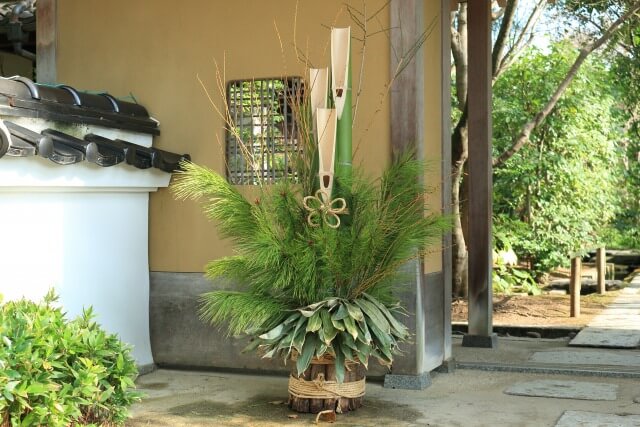

Kadomatsu is a New Year’s decoration made of pine and bamboo that is displayed in front of the house during the New Year.
門松は、お正月に家の前などに飾られる、松や竹で作った正月飾りです。
- Kadomatsu/門松
- New Year/正月
- decoration/飾り
- made of/~でできている
- pine/松
- bamboo/竹
- display/飾る
- in front of/~の前に
- house/家
- during/~の間
- New Year/お正月
It is said that the evergreen tree has a god, and it is said that the origin of Kadomatsu is that the evergreen tree was displayed in front of the house during the New Year.
常緑樹には神様が宿るとされており、お正月に家の前に常緑樹を飾ったのが門松の起源と言われています。
- it is said that/~と言われている
- evergreen tree/常緑樹
- god/神様
- origin/起源
- Kadomatsu/門松
- display/飾る
- in front of/~の前に
- house/家
- during/~の間
- New Year/お正月
Kadomatsu is a landmark for god to come to our house without getting lost.
門松は、神様が迷わずに家へ来ていただくための目印となります。
- Kadomatsu/門松
- landmark/目印
- for/~にとって
- god/神様
- come/来る
- house/家
- without/~なしに
- get lost/道に迷う



(お正月の飾りなのね。)
門松の歴史を英語で説明
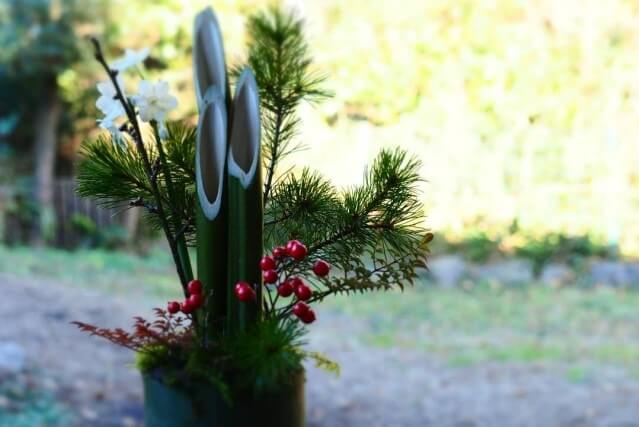

It is said that the custom of decorating the gate with pine branches on New Year’s Day was introduced from China during the Heian period.
お正月に松の枝を門に飾る風習は、平安時代に中国より伝わったと言われています。
- it is said that/~と言われている
- custom/風習
- decorate/飾る
- gate/門
- with/~で
- pine/松
- branch/枝
- New Year’s Day/お正月
- introduce/伝わる
- from/~から
- China/中国
- during/~の間
- Heian period/平安時
In the Heian period literature, there is a waka poem about Kadomatsu.
平安時代の文献には、門松を詠んだ和歌がのっています。
- Heian period/平安時代
- literature/文献
- waka poem/和歌
- about/~についての
- Kadomatsu/門松
A famous essay from the Kamakura period describes a scene in which many Kadomatsu are lined up on the main road of the city.
鎌倉時代の有名な随筆には、都の大路に門松が沢山並んでいる情景が記述されています。
- famous/有名な
- essay/随筆
- Kamakura period/鎌倉時代
- describe/記述する、描写する
- scene/情景
- many/沢山の
- Kadomatsu/門松
- line up/並ぶ
- main road/主要道路、本道
- city/都市、都
In the Edo period, the custom of decorating Kadomatsu until January 7th became established in the Kanto region.
江戸時代になると、関東地方では、門松は1月7日まで飾る習慣が定着しました。
- Edo period/江戸時代
- custom/習慣
- decorate/飾る
- Kadomatsu/門松
- until/~まで
- January 7th/1月7日
- became/become(なる)の過去形
- established/確立した
- Kanto region/関東地方



(門松を飾る習慣は、随分昔からあるのね。)
門松の飾り方を英語で説明
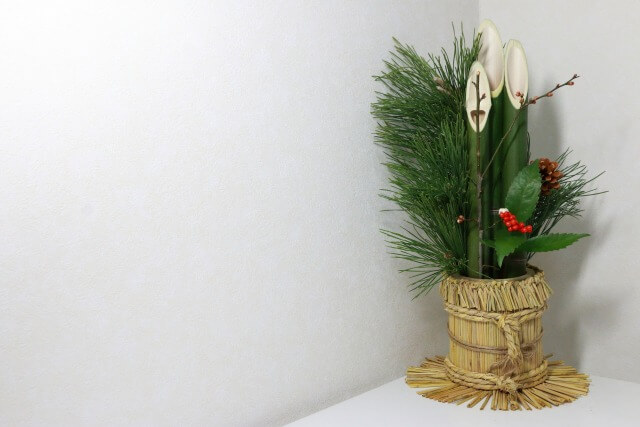

Originally, evergreen trees such as pine were used for Kadomatsu, but since the Kamakura period, bamboo has come to be displayed along with pine.
元々、門松には松などの常緑樹を使っていましたが、鎌倉時代以後、松と一緒に竹も飾るようになりました。
- originally/元々
- evergreen tree/常緑樹
- such as/など
- pine/松
- use/使う
- Kadomatsu/門松
- but/だが、しかし
- since/~以来
- Kamakura period/鎌倉時代
- bamboo/竹
- come to/~するようになる
- display/飾る
- along with/~と一緒に
There are two types of bamboo tips used for kadomatsu, one is to cut diagonally and the other is to cut right beside.
門松に使う竹の先端は、斜めに切るタイプと、真横に切るタイプの2種類があります。
- two/2
- type/種類
- bamboo/竹
- tip/先端
- used/使う
- kadomatsu/門松
- one/1
- cut/切る
- diagonally/斜めに
- right beside/真横に
In the Kanto region, a set of three bamboos is placed in the center, short pine trees are placed around them, and the lower part is wrapped with straw to make kadomatsu.
関東地方では3本組の竹を中心置きに、周囲に短く松を配置し、下部をわらで巻いて門松を作ります。
- Kanto region/関東地方
- a set of/一組の、セットの
- three/3
- bamboo/竹
- place/置く
- center/中心
- short/短い
- pine tree/松の木
- around/周囲に
- lower/下の
- part/部分
- wrap/巻く
- with/~で
- straw/わら
- make/作る
- kadomatsu/門松
In Kansai region, a set of three bamboos is placed in the center, ornamental cabbage are placed in the front, and long pine trees are placed in the rear, and the lower part is wrapped with bamboo to make a kadomatsu.
関西地方では3本組の竹を中心置きに、前面に葉牡丹、後方に長めの松を配置し、下部を竹で巻いて門松を作ります。
- Kansai region/関西地方
- a set of/一組の、セットの
- three/3
- bamboo/竹
- place/置く
- center/中心
- ornamental cabbage/葉牡丹
- front/前に
- long/長い
- pine tree/松の木
- rear/後ろに
- lower/下の
- part/部分
- wrap/巻く
- with/~で
- make/作る
- kadomatsu/門松



(門松にはいろいろな飾り方があるのね。)
門松を飾る時期を英語で説明
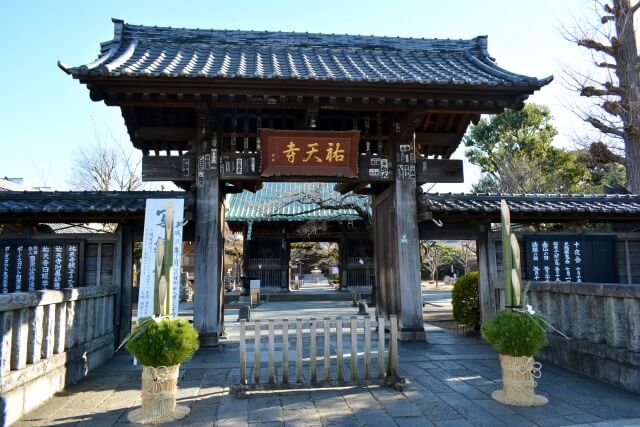

Kadomatsu is generally displayed after December 13th.
門松は、12月13日以降に飾るのが一般的です。
- Kadomatsu/門松
- generally/一般的に
- display/飾る
- after/後
- December 13th/12月13日
The best day to decorate Kadomatsu is December 28th.
門松を飾るのに一番良い日は12月28日とされています。
- the best/最高の
- day/日
- decorate/飾る
- Kadomatsu/門松
- December 28th/12月28日
The number 9 is pronounced the same as suffering, so it is recommended to avoid December 29th.
数字の9が苦しみと同じ発音のため、12月29日は避けた方が良いとされています。
- number/数字
- pronounce/発音する
- same as/~と同様に
- suffering/苦しみ
- so/だから
- recommend/勧める
- avoid/避ける
- December 29th/12月29日
It is said that it is better to avoid December 31st, which is an overnight decoration.
一夜飾りとなる12月31日も、避けた方が良いとされています。
- it is said that/~と言われている
- better/より良い
- avoid/避ける
- December 31st/12月31日
- overnight/一夜の
- decoration/飾り



(12月28日に門松を飾るといいのね。)
門松をしまう時期を英語で説明
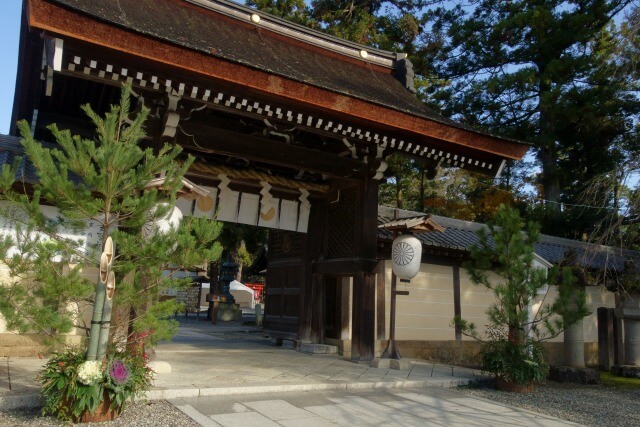

Kadomatsu is decorated during the New Year period, which is called “Matsunouchi”.
門松を飾るのは、「松の内」と言われる正月の期間です。
- Kadomatsu/門松
- decorate/飾る
- during/~の間
- New Year/正月
- period/期間
- call/呼ぶ
- Matsunouchi/松の内
Originally, “Matsunouchi” was until January 15th.
元々「松の内」は、1月15日まででした。
- originally/元々
- Matsunouchi/松の内
- until/~まで
- January 15th/1月15日
In the Kanto region, the last day of “Matsunouchi” has changed to January 7th since the Edo period, so Kadomatsu will be removed on January 7th.
関東地方では、江戸時代以降「松の内」の最終日は1月7日と変更になったため、門松は1月7日にしまわれます。
- Kanto region/関東地方
- the last day/最後の日
- Matsunouchi/松の内
- change to/~に変更する
- January 7th/1月7日
- since/~以降
- Edo period/江戸時代
- so/だから
- Kadomatsu/門松
- remove/片付ける、撤去する
- January 7th/1月7日
Even now, in the Kansai region, Kadomatsu will be removed on January 15th.
現在でも関西地方では、門松は1月15日にしまわれます。
- even now/いまでも
- Kansai region/関西地方
- Kadomatsu/門松
- remove/片付ける、撤去する
- January 15th/1月15日



(関東地方と関西地方では違うのね。)
門松を焼くどんど焼きを英語で説明
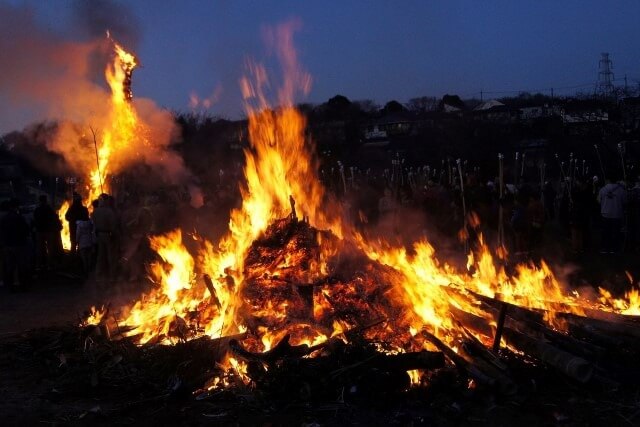

“Dondoyaki” is a fire festival held on January 15th.
「どんど焼き」とは、1月15日に行われる火祭りです。
- Dondoyaki/どんど焼き
- fire festival/火祭り
- held/hold(開催する)の過去形・過去分詞
- January 15th/1月15日
In “Dondoyaki”, the New Year’s decorations are burned with fire.
「どんど焼き」では、正月飾りを火で燃やします。
- Dondoyaki/どんど焼き
- New Year/正月
- decoration/飾り
- burn/燃やす
- with/~で
- fire/火
Burning Kadomatsu with fire means seeing god off with the flames.
門松を火で燃やすのには、神様を炎とともに見送るという意味があります。
- burn/燃やす
- Kadomatsu/門松
- with/~で
- fire/火
- mean/意味する
- see off/見送る
- god/神様
- flame/炎
It is said that you can spend a year in good health by eating rice cakes and dumplings that have been roasted on the fire at this time.
この時の火で炙ったお餅やお団子を食べると、1年間、健康に過ごせると言われています。
- it is said that/~と言われている
- can/できる
- spend/過ごす
- year/年
- in good health/健康で
- by/~によって
- eat/食べる
- rice cake/お餅
- dumpling/お団子
- roast/炙る、焼く
- fire/火
- at this time/この時



(炎とともに神様を見送るのね。)
門松を英語で説明|まとめ
いかがでしたでしょうか?
お正月飾りに欠かせない門松は、神様が家にくるための目印となるものです。
竹と松を中心に飾る門松ですが、地方によって、飾り方も異なります。
門松を飾る時期やしまう時期も、決まっています。
最後は門松を火で焼き、炎と共に神様を見送ります。
竹や松のない国の外国人は、珍しいものばかりで驚くかもしれません。
お正月の、日本らしい飾りである門松について、外国人にも英語で分かりやすく説明してみてください。





